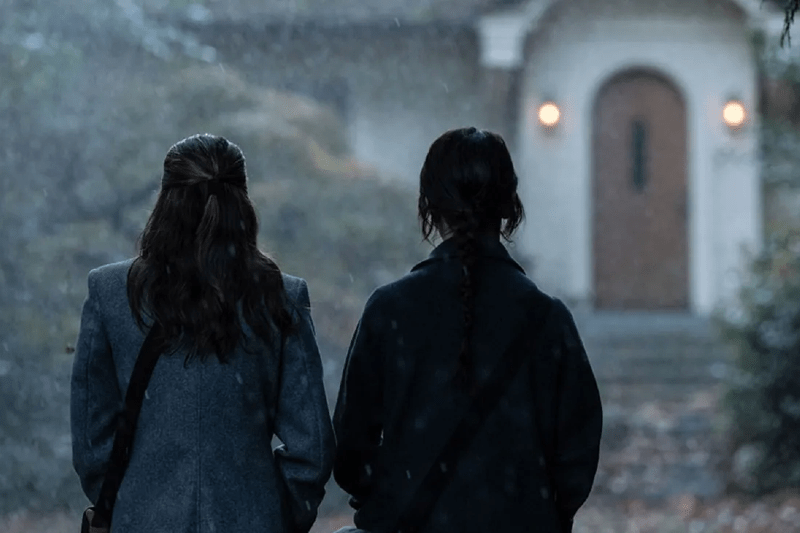Reviews
‘Respati’ Review: Gothic Horror That Mostly Hits the Mark
September 20th, 2024 | By Matthew Monagle

Given the political and religious headlines we wake up to every morning, it is not surprising that possession movies remain a popular vehicle for horror. The loss of bodily autonomy and the threat of the past reaching out to constrict the future are timely themes, and as the possession movie endures, many filmmakers have worked to put their own spin on the genre. Sidharta Tata’s Respati is one such movie – a celebration of Indonesian folk horror that mostly (mostly) succeeds in having something worthwhile to say.
After the death of his parents, Respati (Devano Danendra) suffers from terrible insomnia. While those around him try to help – his grandfather encourages him to talk to a therapist, while his best friend Tirta (Mikha Hernan) tries to distract him with conspiracy theories about a string of local murders – Respati resigns himself to sleepless nights haunted by visions of his undead family. That is, until Respati is singled out by newcomer Wulan (Keisya Levronka), a transfer student who claims to know why Respati is haunted by the faces of the dead.
And then things get worse. Respati is plunged into an unknown dreamscape – a dark and twisted forest where strangers are drawn screaming into the embrace of an unknown entity. As he works with Wulan to better understand what he is seeing, Respati soon discovers that he is the target of an undead witch from his family’s village. Now Respati must learn to harness what fledging skills he has in the dreamscape – and protect his friends from becoming the witch’s latest victims – or watch his entire lineage be wiped out as a brutal act of revenge.
Like the best folk horror, Respati finds interesting ways to blend the modern and the archaic. While both Respati and Wulan have supernatural connections to the spirit world, Tirta’s contributions to the group are that he is extremely good at, well, Googling. This allows him to turn locations or half-forgotten history into concrete steps for his friend group. While the film never fully leans into its cultural divides – the traditions of Respati’s family village are important but never explored outside of an origin story for the witch – the tension between modern and archaic simmers in the background as a nice piece of subtext for audiences to pick at.
Stylistically, there’s also more than a touch of Sam Raimi in the film, which favors soundstages and wind effects over hyper realistic body horror. As the high school students inch closer to discovering the true nature of the demon in Respati’s dreams, Wulan’s connections to the spirit world are turned against her, leading to the kind of gravity defying set pieces that would slot nicely into a film like Drag Me To Hell. It’s a fun return to neoclassical form for the genre, and Respati will be an immediate hit with anyone who prefers a more gothic flavor to their horror.
To that end, the best parts of the movie are also tied to the dreamscape, the non-waking world where the witch claims the souls of the villagers who once oppressed her. Each death is the same: the victim pulls themselves out from the roots of a neighboring tree only to be lured to their death with the promise of a loved one. The dreamscape – and this mode of murder in particular – in Respati offer shades of Tim Burton’s Sleepy Hollow, another film that trades the authenticity of real locations for the dreamlike atmosphere of a quality soundstage.
But despite the film’s thoughtful design elements, it’s hard not to feel like Respati overstays its welcome. With a runtime that pushes two hours, Tata’s movie is not egregiously long by any means, but neither is it quite so narrative-driven as to make good use of those extra 30 minutes. The standout set pieces – a possession in a classroom, a superhero-esque fight between Respati and the witch in the dreamworld – would hit even harder if the mystery surrounding them had less room to wander. Once the pieces are in play, it does not take audiences long to suss out the relationships behind the scene, but the film languishes a bit too long in Respati’s confusion in the first-half.
Respati deserves all the credit in the world for carving out its own path among horror films. It often feels like an undiscovered classic of 1990s gothic horror, both high-touch in its production but measured and careful in its approach to gore. And as Southeast Asia continues to be a breeding ground for powerful genre cinema, Respati clearly deserves a place among the canon of New Indonesian horror. But for as much as it entertains, there is also a sense that the movie never quite cuts as deep as it could have. Would that Tata had swung just a little bit more for the fences in his film about the things that go bump in our dreams. [3/5]



